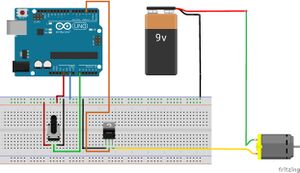Arduino/DC Motors/PWM with transistor: Difference between revisions
Walttheboss (talk | contribs) (Created page with "== Basics == == First Sketch == thumb We use a variable resistor to change the duty cycle. The motor is powered by any DC source. The midd...") |
Walttheboss (talk | contribs) |
||
| Line 1: | Line 1: | ||
== Basics == | ==Basics== | ||
== First Sketch == | ==First Sketch== | ||
[[File:PWM with Transistor.jpg|thumb]] | [[File:PWM with Transistor.jpg|thumb]] | ||
We use a variable resistor to change the duty cycle. | We use a variable resistor to change the duty cycle. | ||
| Line 16: | Line 16: | ||
The potentiometer simply | The potentiometer simply | ||
<nowiki>#</nowiki>define pwm 3 // Use pin 3 for the pwm output. | |||
<nowiki>#</nowiki>define pot A0 // the resistor will go on analog input pin 0 | |||
void setup() // put your setup code here, to run once: | |||
{ | |||
pinMode(pwm,OUTPUT); // Define pin pwm as an output. | |||
pinMode(pot,INPUT); // Define pin pot as an input. | |||
Serial.begin(9600); // Start the serial monitor. | |||
analogWrite(pwm,0); // Make sure the motor is off. | |||
} | |||
void loop() // This is the main code that runs till power off. | |||
{ | |||
float val = analogRead(pot); | |||
float duty = map(val,0,1023,0,255) // Change the input range of 1023 to the output range of 255 | |||
analogWrite(pwm,duty); // Set pin pwm to duty value. | |||
Serial.print("PWM = "); | |||
Serial.print(pwm); // Print the pwm value. | |||
Serial.print(" "); | |||
Serial.println(duty); // Print the Duty value and then do a carriage return. | |||
} | |||
<br /> | |||
Revision as of 15:11, 14 May 2021
Basics
First Sketch

We use a variable resistor to change the duty cycle.
The motor is powered by any DC source.
The middle pin on the transistor is the control pin.
The left(flat/labeled/non-Heatsink) side is the ground.
The right pin is the voltage return to ground.
You power the motor from the positive side of the battery.
The potentiometer simply
#define pwm 3 // Use pin 3 for the pwm output.
#define pot A0 // the resistor will go on analog input pin 0
void setup() // put your setup code here, to run once:
{
pinMode(pwm,OUTPUT); // Define pin pwm as an output.
pinMode(pot,INPUT); // Define pin pot as an input.
Serial.begin(9600); // Start the serial monitor.
analogWrite(pwm,0); // Make sure the motor is off.
}
void loop() // This is the main code that runs till power off.
{
float val = analogRead(pot);
float duty = map(val,0,1023,0,255) // Change the input range of 1023 to the output range of 255
analogWrite(pwm,duty); // Set pin pwm to duty value.
Serial.print("PWM = ");
Serial.print(pwm); // Print the pwm value.
Serial.print(" ");
Serial.println(duty); // Print the Duty value and then do a carriage return.
}